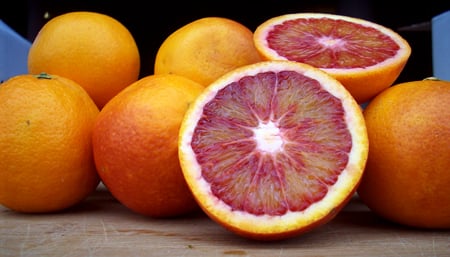
What makes an orange orange?
Well, technically the English word for the color wasn't recorded until several centuries after the fruit appeared in Europe, so orange is the color of the fruit and not the other way around.
An orange (the fruit) is a hybrid between a pomelo and a grapefruit. The first oranges were, in fact, green and many of them still are for most of their lifespan. Oranges only turn their eponymous color as a result of cold temperatures breaking down the chlorophyll in the fruit's skin.
But some oranges aren't orange at all! In fact, two of the sweetest, most flavorful oranges you can find are red.
Keep scrolling to learn about the Cara Cara and Blood Oranges.
 The seedless Cara Cara orange is a beautiful fat free, sodium free, and cholesterol free snack.
The seedless Cara Cara orange is a beautiful fat free, sodium free, and cholesterol free snack.Cara Cara Navel Orange
Coloring: Cara Cara oranges have a yellowish-orange peel and looks nearly identical to a standard navel orange from the outside. But slice one open and you'll discover a bright pinkish-red flesh. This coloring is caused by an abundance of lycopene, a caratenoid and powerful antioxidant that gives tomatoes their vibrant glow.
Flavors: Sweet and tangy with hints of cherry and notes of cranberry and blackberry. Cara Cara oranges have a low acid content. Though they look like small grapefruits, they are far sweeter.
Nutrients: 80 Calories, 150% RDA Vitamin C, 30% RDA Vitamin A.
(Serving: 1 medium cara cara)
Fun Fact: The Cara Cara orange was discovered in 1976 at Hacienda Cara Cara in Venezuela. A naturally occurring mutation of the Washington navel orange, this flavorful citrus was first introduced to the United States via Florida, but California is now home to the most Cara Cara groves in the country.
The Best Cara Cara Orange Recipe:
Kale Salad with Orange Champagne Vinaigrette
 The anthocyanins that give blood oranges their distinctive coloring mop up cancer causing free radicals in the body.
The anthocyanins that give blood oranges their distinctive coloring mop up cancer causing free radicals in the body.Moro Blood Orange
Coloring: Unlike a Cara Cara orange, a blood orange’s skin betrays its colorful interior. The skin can range from light orange to dark orange with some distinctive red marbling. Blood oranges get their name from their deep maroon juice and flesh. Their coloring is caused by the presence of anthocyanin, the same antioxidant that makes blueberries blue and cranberries red.
Flavors: Moro blood oranges are a complex blend of sweet and tart with plum and raspberry-like overtones.
Nutrients: 70 Calories, 110% RDA Vitamin C, 260mg Potassium.
(Serving: 1 moro orange)
Fun Fact: Blood oranges grow particularly well in a Mediterranean climate where the days are warm, but the nights are cool. While most of our blood oranges come from Florida or California, Italy is one of the top producers of blood oranges. In addition to the more familiar Moro blood orange, Italians also grow two special varieties of blood orange, the Tarocco and the Sanguinello.
The Best Blood Orange Recipe:
Blood Orange Marmalade


